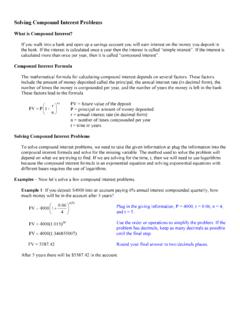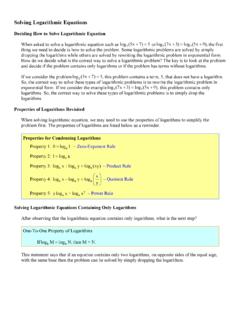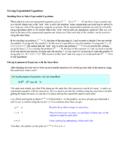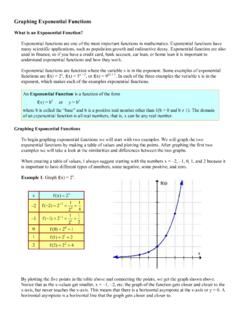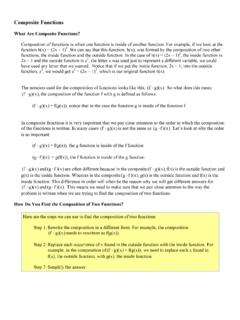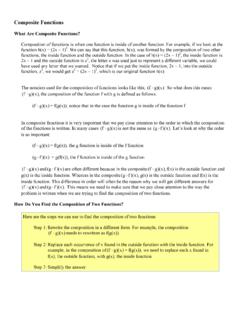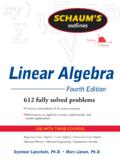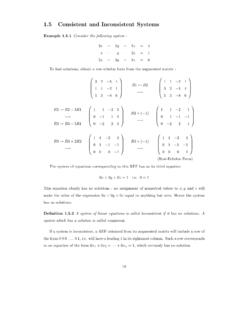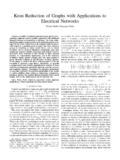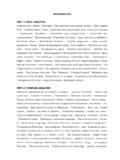Transcription of Using Matrix Elimination to Solve Three Equations …
1 Using Matrix Elimination to Solve Three Equations With Three Unknowns Notes Page 1 of 6 Using Matrix Elimination to Solve Three Equations with Three Unknowns Here we will be learning how to use Matrix Elimination to Solve a linear system with Three Equations and Three unknowns. Matrix Elimination is one of many techniques that can be used to Solve systems of linear Equations . Matrix Elimination is also known as Gaussian Elimination named after Carl Friedrich Gauss. Matrix Elimination involves a series of steps that transforms an augmented Matrix into what is known as row echelon form. First, let s explain what an augmented Matrix is. An augmented matric is used to represent a system of linear Equations and in an augmented Matrix the variables must be on the left hand side of the equal sign and the constants on the right hand side of the equal sign.
2 If any of the variables are missing, we must write a zero in place of the missing variable. To help with the explanation we are going to use the following problem: 2x+3y z=14x+y 3z=113x 2y+5z=21 The augmented Matrix looks like this: [23 1141 3113 2521] As mentioned earlier the goal of Matrix Elimination is to transform the augmented Matrix into row echelon form. So what is row echelon form? Row echelon form is obtained when all of the numbers below the diagonal are 0 and all of the numbers in the diagonal are 1. Although I personally do not require my student s to make all of the numbers is the diagonal a 1 because they can still Solve the problem without turning the numbers in the diagonal into a 1. [23 1141 3113 2521] Using our example, the goal is to turn the numbers highlighted in red into 0 s and the numbers highlighted in blue into 1 s.
3 Again, I do not require my student s to change the numbers in the diagonal into 1 s to Solve the problem. In the examples that follow I will only be showing how to find the required 0 s. Changing the numbers in the diagonal into 1 s is relatively simple and often results in lots of fractions. The fractions can be avoided if you do not change the numbers in the diagonal into 1 s. The rules that determine what we can and cannot do to a augmented Matrix are called row operations. There are Three basic row operations: 1. Interchange any two rows. 2. Replace a row by a nonzero multiple of that row. 3. Replace a row by the sum of that row and a constant nonzero multiple of some other row. Now here is the translation: Rule 1 say that we can swap any two rows that we want. I personally rarely use this rule. Rule 2 say that we can multiply or divide a row by any number that we want except zero.
4 This rule is useful for creating the 1 s in the diagonal if needed. Rule 3 says that we can multiply any two rows by any numbers we want except zero and then add the two row together. This rule is the rule that is used to create the 0 s below the diagonal. These rules will make more sense when we see them being used. Using Matrix Elimination to Solve Three Equations With Three Unknowns Notes Page 2 of 6 Now we can take a look at the notation that will be used. For example, we might see something like 3R1 + 4R2 = R2. This is an example of Rule 3 in action, 3R1 + 4R2 = R2 is telling the reader that we are going to multiply row 1 by 3, multiply row 2 by 4, then add the two rows together and place the result in row 2. The numbers that we multiply row 1 and row 2 change from problem to problem and are chosen carefully to make sure that we end up with a zero below the diagonal.
5 Back to our example: [23 1141 3113 2521] The first thing we need to accomplish now is to turn the 4(in red above) into a 0. We will do this by Using rows one and two and placing the result back into row two. So we need to figure out what to multiply row 1 and 2 by so that if we add them together the 4 turns into a 0. Generally, the easiest way to do this is to switch the two numbers in the x column, meaning that we should multiply row one by 4 and row two by 2. At this point if we add them together 8 + 8 = 16 not 0. So after switching the two numbers, we always need to ask ourselves if we need a negative sign. In this case, we need a negative sign because 8 + 8 = 0. It does not matter whether we make the 2 or the 4 negative, but one of them must be negative so that they add up to 0. The notation would look like this: 4R1 + 2R2 = R2 4 2((24 31 1 3 111)) + 8 8 0 12 2 10 4 6 2 42218 In the new augmented Matrix (on the right) row two has been replace by the new row two found in the previous step and we have our first 0 in place.
6 [23 110 10 2183 2521] The next thing we need to do is to turn the 3(in red above) into a 0. We will do this by Using rows one and Three and placing the result back into row Three . Again we will switch the numbers in x-column rows one and Three and we will need to make one of the numbers negative because right now both numbers are positive. The notation would look like this: 3R1 + 2R3 = R3 3 2((23 3 2 1 5 121)) + 6 6 0 9 4 13 31013 34239 In the new augmented Matrix (on the right) row Three has been replace by the new row Three found in the previous step and we have our second 0 in place. [23 110 10 2180 131339] The next thing we need to do is to turn the 13(in red above) into a 0. We will do this by Using rows two and Three and placing the result back into row Three . This time we will switch the numbers in y-column rows two and Three and we will need to make one of the numbers negative because right now both numbers are negative.
7 Using Matrix Elimination to Solve Three Equations With Three Unknowns Notes Page 3 of 6 The notation would look like this: 13R2 + 10R3 = R3 13 10((00 10 13 213 1839)) + 000 130 130 0 26130156 234 390 156 In the new augmented Matrix (on the right) row Three has been replace by the new row Three found in the previous step and we have our final 0 in place. [23 110 10 21800156156] We are now ready to the solution. We start with the bottom row and work our way back up to the top row Using back substitution. Here is what it looks like. Using row Three : 156z = 156 z = 1 Using row two: 10y 2y = 18 10y 2(1) = 18 10y 2 = 18 10y = 20 y = 2 plug in z = 1 and Solve for y Using row one: 2x + 3y z = 1 2x +3( 2) 1 = 1 2x 7 = 1 2x = 8 x = 4 plug in z = 1, y = 2, and Solve for x The solution to the problem written as an order triple is (4, 2, 1).
8 Note: If we need to continue on to row echelon form all we would have had to do is divide each row by the number in the diagonal. In the previous example, we would have divided row one by 2, divided row two by 10, and divided row Three by 156. This would have resulted in the augmented Matrix (shown below) that is truly in row echelon form. [13/2 1/21/2011/5 9/50011] To summarize, here are the steps used to Solve Three Equations with Three unknowns by Matrix Elimination : Step 1: Write the augmented Matrix Step 2: Use rows one and two to create the first zero in row two. Step 3: Use rows one and Three to create the second zero in row Three . Step 4: Use rows two and Three to create the third and final zero in row Three . Step 5: Use back substitution to find the values of x, y, and z. Now let s work through a few more examples.
9 Using Matrix Elimination to Solve Three Equations With Three Unknowns Notes Page 4 of 6 Example 1: Use Matrix Elimination to Solve : 4x 2y+3z=11x+4y+2z= 123x+y 5z=8 Step 1: Write the Augmented Matrix . 4x 2y+3z=11x+4y+2z= 123x+y 5z=8 [4 2311142 1231 58] Step 2: Use rows one and two to create the first zero in row two. We need to multiply row one by 1 and row two by 4 R1 + 4R2 = R2 1 4((41 2 4 32 11 12)) + 4 4 0 21618 3 8 5 11 48 59 [4 23110185 5931 58] Step 3: Use rows one and Three to create the second zero in row Three . We need to multiply row one by 3 and row Three by 4 3R1 + 4R3 = R3 3 4((43 2 1 3 5 11 8)) + 12 12 0 6410 9 20 29 33 32 1 [4 23110185 59010 29 1] Step 4: Use rows two and Three to create the final zero in row Three . We need to multiply row two by 10 and row Three by 18 10R2 + 18R3 = R3 10 18((00 1810 5 29 59 1)) + 000 180 180 0 50 522 572 590 18572 [4 23110185 5900 572572] Step 5: Use back substitution to find the values of x, y, and z.
10 Using row Three : 572z = 572 z = 1 Using row two: 18y + 5z = 59 18y + 5( 1) = 59 18y 5 = 59 18y = 54 y = 3 plug in z = 1 and Solve for y Using row one: 4x 2y + 3z = 11 4x 2( 3) + 3( 1) = 11 4x + 3 = 11 2x = 8 x = 4 plug in z = 1, y = 3, and Solve for x The solution to the problem written as an order triple is (4, 2, 1). Using Matrix Elimination to Solve Three Equations With Three Unknowns Notes Page 5 of 6 Example 2: Use Matrix Elimination to Solve : 3x 5y+z= 23 2x+3y 3z=194x+5z= 18 Step 1: Write the Augmented Matrix . 3x 5y+z= 23 2x+3y 3z=194x+5z= 18 [3 51 23 23 319405 18] Step 2: Use rows one and two to create the first zero in row two. We need to multiply row one by 2 and row two by 3 2R1 + 3R2 = R2 23(( 3 2 5 3 1 3 23 19)) + 6 6 0 10 9 1 2 9 7 46 57 11 [3 51 230 1 711405 18] Step 3: Use rows one and Three to create the second zero in row Three .
